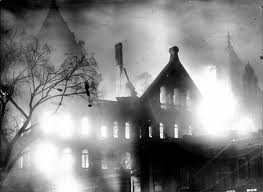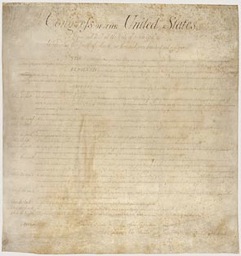by columnist Madeline Karp
There are two things in this life that I particularly love: early American history, and a good dramatic mystery.
So of course, when news broke that Pennsylvania’s original copy of the Bill of Rights may have been found in the New York Public, my ears pricked up and I started tuning in to the unfolding drama. Don’t know the story? That’s okay! Dispatches from the Mid-Atlantic now presents:
The Wandering Bill of Rights: A Tale of Provenance
Act 1: In which Pennsylvania’s Copy of the Bill of Rights goes missing
1789. New President George Washington dispatches thirteen copies of the Bill of Rights to the new states for ratification. One copy is kept for the Federal Government.
A shadowy figure – a man, about whom there are few details – decides he has some problem with Pennsylvania specifically, and begins selling the state’s important historic documents on the black market in New York City. Pennsylvania’s copy of the Bill of Rights goes missing without a trace.
Act 2: In which an unaccounted copy is found in the New York Public Library
1898. A wealthy New York collector donates a copy of the Bill of Rights to the New York Public Library. The document has no other provenance record, and is assumed to belong to New York. The Library displays the document on and off for several years, before pulling it permanently, citing preservation concerns.
1911. A fire breaks out in Albany, New York’s capital, destroying the state archives and library. Experts wipe their brows in relief – New York’s copy of the Bill of Rights is safely ensconced in New York City. Or is it?
INTERMISSION.
Act 3: In which a museum becomes involved
2003. Pennsylvania, Georgia and Maryland have all misplaced their original copies of the Bill of Rights. One unaccounted-for copy is for sure on the black market; another found a home in the Library of Congress.
Enter Stephen Harmelin, a lawyer from the state of Pennsylvania who has been diligently working to prove that the NYPL’s copy of the Bill belongs to his state. Evidence suggests that New York’s copy did burn in the 1911 fire and that the NYPL’s copy belongs to Pennyslvania, but Harmelin increasingly runs into problems reclaiming ownership of the Bill.
“It’s not good enough to conclude that a document may or may not have originated in Pennsylvania,” he says. “…You also have to demonstrate that it unlawfully left Pennsylvania.” Harmelin’s case becomes bogged down in frustrating legal technicalities.
Meanwhile, the National Constitution Center in Philadelphia is on the verge of purchasing an original copy of the Bill of Rights from an antiques dealer to put on display as “Pennsylvania’s copy” of the document. Upon hearing the news, Harmelin contacts the Center’s president, Joe Torsella, with some concerns about the document.
Torsella decides to continue with the purchase when – PLOT TWIST – the purchase is really an FBI sting. The dealer is arrested and the black market copy is returned to its original state…which is neither Maryland or Georgia, but North Carolina.
Epilogue: In which New York and Pennsylvania reach a compromise
Present Day. The New York Public Library concedes that their copy probably does belong to Pennsylvania. Rather than get bogged down in the legalities of ownership, the states broker a deal of joint stewardship. NYPL loans the document to the Constitution Center for three years, and agrees to let it travel around the state if host institutions meet the required security and exhibition standards.
Our hero, Harmelin, joins the Constitution Center’s Board of Trustees.
FIN.
This could totally be a docu-drama right? Right?
Or maybe I’m being a total nerd.
Mark you calendars! You can see Pennsylvania’s Wandering Bill of Rights on display at the National Constitution Center starting in 2014.
—
To read the less dramatic version of the tale, check out the full article here on philly.com.
For more about the lost Bills of Rights, check out David Howard’s book Lost Rights.



Leave a Reply